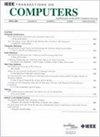DCGG: A Dynamically Adaptive and Hardware-Software Coordinated Runtime System for GNN Acceleration on GPUs
IF 3.8
2区 计算机科学
Q2 COMPUTER SCIENCE, HARDWARE & ARCHITECTURE
引用次数: 0
Abstract
Graph neural networks (GNNs) are a prominent trend in graph-based deep learning, known for their capacity to produce high-quality node embeddings. However, the existing GNN framework design is only implemented from the algorithm level, and the hardware architecture of the GPU is not fully utilized. To this end, we propose DCGG, a dynamic runtime adaptive framework, which can accelerate various GNN workloads on GPU platforms. DCGG has carried out deeper optimization work mainly in terms of load balancing and software and hardware matching. Accordingly, three optimization strategies are proposed. First, we propose dynamic 2D workload management methods and perform customized optimization based on it, effectively reducing additional memory operations. Second, a new slicing strategy is adopted, combined with hardware features, to effectively improve the efficiency of data reuse. Third, DCGG uses the Quantitative Dimension Parallel Strategy to optimize dimensions and parallel methods, greatly improving load balance and data locality. Extensive experiments demonstrate that DCGG outperforms the state-of-the-art GNN computing frameworks, such as Deep Graph Library (up to 3.10基于gpu的GNN加速动态自适应软硬件协调运行时系统
图神经网络(gnn)是基于图的深度学习的一个突出趋势,以其产生高质量节点嵌入的能力而闻名。然而,现有的GNN框架设计仅从算法层面实现,并未充分利用GPU的硬件架构。为此,我们提出了一个动态运行时自适应框架DCGG,它可以在GPU平台上加速各种GNN工作负载。DCGG主要在负载均衡和软硬件匹配方面进行了更深入的优化工作。据此,提出了三种优化策略。首先,我们提出了动态二维工作负载管理方法,并在此基础上进行定制化优化,有效减少了额外的内存操作。其次,采用新的切片策略,结合硬件特性,有效提高数据复用效率;第三,DCGG采用定量维度并行策略对维度和并行方法进行优化,极大地提高了负载均衡性和数据局部性。广泛的实验表明,DCGG在各种数据集的主流GNN架构上优于最先进的GNN计算框架,如深度图库(高达3.10$\boldsymbol{\times}$快)和GNNAdvisor(高达2.80$\boldsymbol{\times}$快)。
本文章由计算机程序翻译,如有差异,请以英文原文为准。
求助全文
约1分钟内获得全文
求助全文
来源期刊

IEEE Transactions on Computers
工程技术-工程:电子与电气
CiteScore
6.60
自引率
5.40%
发文量
199
审稿时长
6.0 months
期刊介绍:
The IEEE Transactions on Computers is a monthly publication with a wide distribution to researchers, developers, technical managers, and educators in the computer field. It publishes papers on research in areas of current interest to the readers. These areas include, but are not limited to, the following: a) computer organizations and architectures; b) operating systems, software systems, and communication protocols; c) real-time systems and embedded systems; d) digital devices, computer components, and interconnection networks; e) specification, design, prototyping, and testing methods and tools; f) performance, fault tolerance, reliability, security, and testability; g) case studies and experimental and theoretical evaluations; and h) new and important applications and trends.
 求助内容:
求助内容: 应助结果提醒方式:
应助结果提醒方式:


